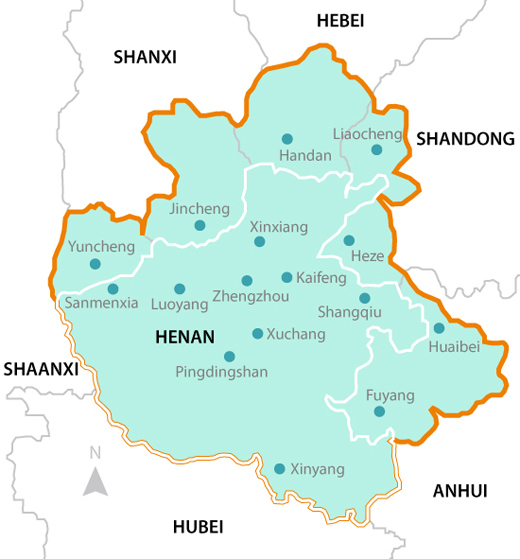China Approves Plan for Creation of the Central Plains Economic Zone
Jan. 3 – To support the balanced development of different regions within the country, China’s State Council officially approved the “Planning for a Central Plains Economic Zone (2012-2020) (guohan [2012] No.194, hereinafter referred to as the ‘Planning’)” on November 17, 2012. The proposed economic zone would cover the entirety of Henan Province, as well as twelve municipalities and two counties in the adjoining provinces of Shandong, Anhui, Hebei, and Shanxi.
The Central Plains Economic Zone (CPEZ) represents the largest economic zone in the country in terms of area and population, boasting a total area of 289,000 square meters and a population of roughly 179 million. Traditionally referred to as China’s “great granary,” the central plains region has long been a leading area for agricultural production – currently contributing to 18 percent of the nation’s total grain output and 50 percent of its total wheat output. Therefore, problems such as reduced farmland, decreases in grain output, and environment degradation faced by the region on its way to modernization are even more challenging than China’s other economic zones. In response, the Planning that has been approved by the State Council offers a coordinated way for the CPEZ to undergo urbanization, industrialization and agricultural modernization without compromising its agricultural development, food security and environment.
Strategic positioning
According to the Planning, the Central Government will turn the CPEZ into a key grain producing region and a modern agricultural base; a national model of coordinated development in industrialization, urbanization and agricultural modernization.
Development goals
As provided by the Planning, the preliminary planning of the CPEZ will take shape by 2015, and will be further built out into “a prosperous, environmentally friendly region” by 2020.
The key development goals of the CPEZ are listed as follows:
- Annual per-capita GDP in the region will increase from the RMB26,317 witnessed in 2011 to RMB60,000 in 2020
- The region’s share of China’s total GDP will rise from 9 percent in 2011 to 10.5 percent in 2020
- Overall grain production will increase from the 93.26 million tons realized in 2011 to 108 million tons by 2020
- The annual per-capita disposable income levels of urban residents will increase from RMB17,813 recorded in 2011 to RMB38,000 in 2020
- The annual per-capita net income levels of rural residents will increase from RMB6,629 recorded in 2011 to RMB16,000 in 2020

The inclusive geographical spread of the Central Plains Economic Zone (Source: Asia Briefing Ltd.)
Dezan Shira & Associates is a specialist foreign direct investment practice, providing corporate establishment, business advisory, tax advisory and compliance, accounting, payroll, due diligence and financial review services to multinationals investing in emerging Asia.
For further details or to contact the firm, please email china@dezshira.com, visit www.dezshira.com, or download the company brochure.
You can stay up to date with the latest business and investment trends across China by subscribing to The China Advantage, our complimentary update service featuring news, commentary, guides, and multimedia resources.
Related Reading
Understanding China’s Development Zones
China Releases 12th Five-Year Plan for Domestic Trade Development
China Releases 12th Five-Year Plan for Solar Power Development
China Releases 12th Five-Year Plan for Waste Recycling Technology
China Releases 12th Five-Year Plan for Trade in Electromechanical and High-Tech Products
China Releases Blueprint to Promote Seven Emerging Industries
China Releases 12th Five-Year Plan for Oceanic Affairs
China Releases 12th Five-Year Plan for Foreign Trade Development
- Previous Article China Releases Annual Report on Advance Pricing Arrangements
- Next Article China Initiates New Round of Minimum Wage Increases










